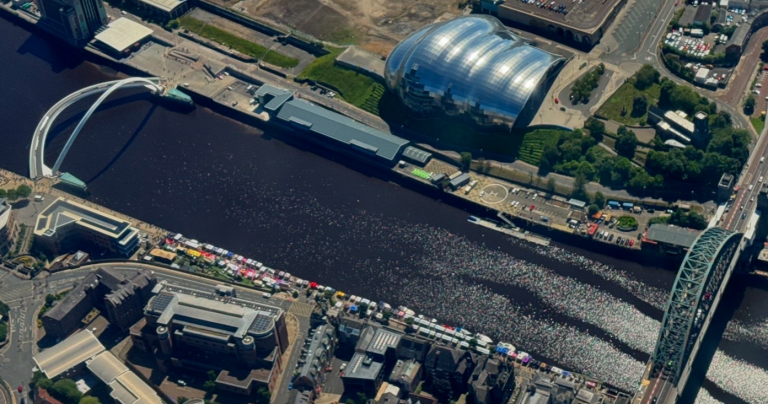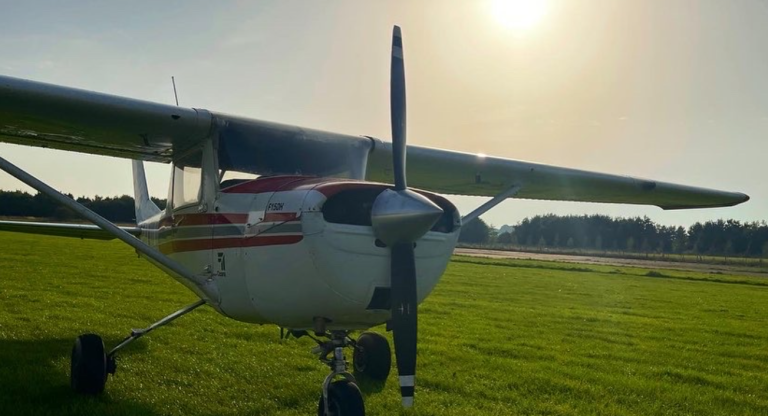I’ve spoken a bunch of times about the weather looking grim on my drive north to the airfield only for its little micro-climate to win out and blue skies to be waiting for me on arrival.
But not this time.
Checking the weather at local RAF Boulmer’s weather station, it showed the cloud base (the lowest level of visible cloud) was only 600ft above mean sea level (MSL). With a circuit height of 1,200ft above MSL and a requirement to remain “clear of cloud and within sight of the surface” to observe Visual Flight Rules, this was going to pose a problem for us.
The wind was also problematic – it was 12 knots (about 15mph) from 320 degrees-ish, and gusting.
My aircraft sat uncovered and waiting on the parking apron, while the aircraft around it slept snugly under covers and blankets.
On a Wing and a Prayer
Today was supposed to be my first solo circuits lesson – an hour of lapping the airfield with landings and take-offs on each lap. With the weather being so changeable and it being 3 weeks since my last lesson – my first solo – my instructor said it was best if he came up for a couple of circuits to assess the weather and my flying before letting me loose. I whole-heartedly agreed.
I headed out to the aircraft, the classic straight-tailed Cessna 150E I solo’d in and had completely fallen in love with, and pre-flighted her. I even found a good mounting place for the Go Pro I borrowed from a friend but in my haste to get going before the clouds rolled in I failed to press the correct combination of buttons and sadly it didn’t record. But I know what to do next time.
I started the engine, made the radio calls and taxiied to the holding point at the end of the runway heading 010 degrees on the compass to do the power checks. Everything was fine so I made another radio call, “Golf-Zulu-Uniform lining up for departure, runway 01”, and taxiied into position on the runway.
At the other end of the runway, beyond the village at the upwind end, was a wall of cloud.
I pushed the power fully forward adding a bit of left aileron (into the wind) and a lot of right rudder – that wind from the left combining with the wash from the propeller creating a large force on the left side of the tail fin, trying to push the nose left.
It felt like it took forever to accelerate to 60 knots but once the air speed indicator showed 60 I gently pulled back and we launched into the convective air. Immediately after take off we started to get bumped around, at 200ft we got pushed down by a column of descending air – our nose still pointing up and the air speed indicator still showing 60 knots but our VSI, vertical speed indicator, suddenly trending downward.
Thankfully, it lasted only a second or two before, with a sigh of relief, I was able to start climbing out again. At 300ft I brought the flaps up and at 700ft I turned onto crosswind, keeping the nose pointing slight into the wind to counteract the drift. It was only once we were on downwind that the air smoothed out a bit and before long I was pulling back the power and configuring for landing. Flaps to 20 degrees and I turned left onto base leg. At 600ft I turned onto final and made the mandatory radio call, “Golf-Zulu-Uniform final runway zero-one.”
Approach 1
I kept the speed on 60 knots but really struggled to get lined up with the centreline on the runway, the wind was causing the tail to swing left and right and I just couldn’t tame it.
Coming over the trees at the end of runway 01 I was a bit high and a bit fast, I pulled the power back in the hope that I could clinch victory from the jaws of defeat but the wind had other ideas – over the trees and the aircraft dropped suddenly before lifting us and then blowing us over toward the parking apron.
At about 40 feet above the ground I really wasn’t comfortable proceeding and I pushed the throttle fully open, carefully pointing the nose back into the sky.
“Good decision,” said the instructor, who I’d mostly forgotten was still sitting there! “I was about one second away from taking the controls and doing exactly that.”
This climb was as bumpy and draughty as the first and when I tried to turn onto crosswind the cloud had started to descend into our path. I turned onto downwind a little earlier than the first time around and made the mandatory radio call – “Golf-Zulu-Uniform, downwind runway 01.” And then ran through the BUMFILCH checks that will be familiar to you by now if you’ve read the other lessons!
The cloud was starting to bunch up around the fringes of the circuit and splashes of moisture kept hitting the windscreen.
Turning to overfly Northumberland’s picturesque Linden Hall, and give us a wider base leg I configured for landing:
- Carb heat hot
- Throttle to 1500rpm
- 20 degrees of flap
- Wait for 60 knots and then descend at 60
Approach 2
I misjudged our position a bit and the base leg ended up quite short, so I pulled the throttle back trading altitude to maintain 60 knots of airspeed.
“Let’s do a full stop landing on this one,” said the instructor. We’d done our best but it was time to throw in the towel.
The wind was the same this time, gusty and unpleasant but I was on a better approach profile and, the main thing I believe made a difference, I was a lot more positive on the rudder pedals and kept the nose under control. As we came over the trees I pulled the throttle back, prepared for the sideways gust that hit us the first time round but it never came.
Over the numbers I pulled back on the controls to arrest the descent rate and used the rudder pedals to keep straight on the centre line.
About 1/4 of the way down the runway the tyres almost imperceptibly kissed the tarmac and the weight of the Cessna gently settled onto the oil-filled suspension struts.
It was easily my softest landing yet.
“What a landing!” said my instructor.
We parked up, shut her down and then began to walk back to the clubhouse, I was buzzing with adrenaline. And then my instructor dropped a bombshell.
The Bombshell
“I’m afraid that will be our last lesson together as I’ve got a job with the airlines and I start next week.”
Oh no!
I’d already lost one instructor to the tartan-tailed regional in question so this was a bit gutting. Building a rapport with and demonstrating what you can do to your instructor takes time and, while I’m over the moon for my instructor starting his new career, I know I’m going to have to build trust with another new instructor, starting from the next lesson.
But that’s aviation – you get ups and downs. And anything worth doing is worth persevering through the downs.
So that was the lesson, with a grand total of 10 minutes airborne in the log book and zero minutes of GoPro footage recorded, I made my way back down the motorway home.



